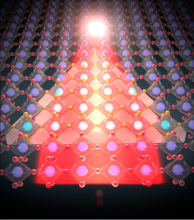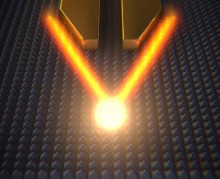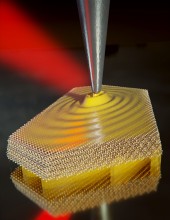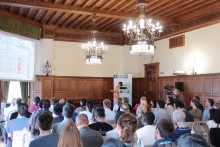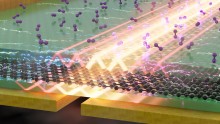Related news by tag NANOOPTICS
Nature Materials: Graphene plasmons go ballistic
This problem has now been solved, as shown by researchers from ICFO (Barcelona), in a collaboration with nanoGUNE, CNR/Scuola Normale Superiore (Pisa, Italy) – members of the EU Graphene Flagship – and Columbia University (New York, USA).
 Since the discovery of graphene, many other two-dimensional materials have been isolated in the laboratory. One example is boron nitride, a very good insulator. A combination of these two unique two-dimensional materials has provided the solution to the quest for controlling light in tiny circuits and suppression of losses. When graphene is encapsulated in boron nitride, electrons can move ballistically for long distances without scattering, even at room temperature. This new research shows that the graphene/boron nitride material system is also an excellent host for extremely strongly confined light and suppression of plasmon losses.
Since the discovery of graphene, many other two-dimensional materials have been isolated in the laboratory. One example is boron nitride, a very good insulator. A combination of these two unique two-dimensional materials has provided the solution to the quest for controlling light in tiny circuits and suppression of losses. When graphene is encapsulated in boron nitride, electrons can move ballistically for long distances without scattering, even at room temperature. This new research shows that the graphene/boron nitride material system is also an excellent host for extremely strongly confined light and suppression of plasmon losses.
The research, carried out by ICFO PhD students Achim Woessner and Yuando Gao and postdoctoral fellow Mark Lundeberg, is just the beginning of a series of discoveries on nano-optoelectronic properties of new heterostructures based on combining different kinds of two-dimensional materials. The material heterostructure was first discovered by the researchers at Columbia University.
Ikerbasque Professor Rainer Hillenbrand, nanoGUNE’s Nanooptics group leader, comments: “Now we can squeeze light and at the same time make it propagate over significant distances through nanoscale materials. In the future, low-loss graphene plasmons could make signal processing and computing much faster, and optical sensing more efficient.”
The research team also performed theoretical studies. Marco Polini, from CNR/Scuola Normale Superiore (Pisa) and the IIT Graphene Labs (Genova, Italy), laid down a theory and performed calculations together with their collaborators.
These findings pave the way for extremely miniaturized optical circuits and devices that could be useful for optical and/or biological sensing, information processing or data communications.
Original Publication
A. Woessner,M. B. Lundeberg, Y. Gao, A. Principi, P. Alonso-González, M. Carrega, K. Watanabe, T. Taniguchi, G. Vignale, M. Polini, J. Hone, R. Hillenbrand, and F. H. L. Koppens
Nature Materials (2014) Highly confined low-loss plasmons in graphene–boron nitride heterostructures
Understanding nanolight refraction on highly anisotropic materials
Light refraction accounts for the change of direction and speed that a wave undergoes when passing from one medium to another. Glasses and contact lenses, microscopes and telescopes, or something as commonplace as the fact that a pencil inserted into a glass of water appears bent when viewed from the outside, have their origin in the optical phenomenon of refraction.
Review: Nanoscale terahertz scanning probe microscopy
Terahertz radiation has become an important diagnostic tool in the development of new technologies. However, the diffraction limit prevents terahertz radiation (λ ≈ 0.01–3 mm) from being focused to the nanometer length scale of modern devices. In response to this challenge, terahertz scanning probe microscopy techniques based on coupling terahertz radiation to subwavelength probes such as sharp tips have been developed.
Researchers develop an innovative strategy to focus infrared light into the nanoscale
Focusing of light into the nanoscale represents a landmark for the implementation of nanotechnology in optics and biochemistry. Based on the exotic propagation of light in highly anisotropic materials (where light propagates in the form of rays along specific directions), a research team led by the University of Oviedo has demonstrated the focusing of infrared light into extraordinarily small regions.
Researchers observe extremely squeezed directional THz waves in thin semiconductor crystals
Polaritons are hybrid states of light and matter that arise from the coupling of light with matter excitations. Plasmon and phonon polaritons are among the most prominent examples, formed by the coupling of light to collective electron oscillations and crystal lattice vibrations, respectively. They play a crucial role in various applications, from sub-diffraction optical spectroscopy and ultrasensitive chemical sensors to ultracompact modulators for communication applications.
Teaching the world about cutting-edge tools for nanoscale optical imaging
s-SNOM and nano-FTIR are unique optical imaging and spectroscopy tools that enable nanoscale imaging and spectroscopy in a broad spectral range, between visible and terahertz frequencies. Rainer Hillenbrand was one of the researchers involved in the development of these techniques and their commercialization, opening a completely new field of experimental research of optical phenomena and materials properties at the nanoscale.
Pablo Alonso-González, Winner of the RSEF-BBVA Foundation 2014 prize
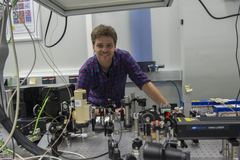
After getting his PhD, he began to work as a post-doctoral researcher in the Nanooptics group of nanoGUNE led by the Ikerbasque researcher Rainer Hillenbrand, where he is now doing his research work. Some of his pieces of work on the optical properties of nanoscale graphene have been published in journals of major international prestige like Nature and Science. In an article recently published in Science, he showed experimentally that confined nanoscale light in graphene obeys the laws of conventional optics, which constitutes the first step towards the development of two-dimensional nanooptics.
RSEF-BBVA Foundation Awards for Physics [www.resef.es]
The Royal Spanish Society for Physics (RSEF), founded in 1903, began to award these prizes in 1958 to recognize creativity and effort and to encourage researchers, young ones in particular. The awards are divided into the following sections: The RSEF Medal, totalling 15,000 euros; New Researcher, in two categories, Theoretical Physics and Experimental Physics, each worth 4,000 euros; Physics Education and Popularisation in two categories, University Education and Secondary Education (8,000 euros each); Physics, Innovation and Technology (8,000 euros); Best Papers in RSEF publications (two prizes, one for education and the other for research, each worth 1,500 euros). The BBVA Foundation has been collaborating with the RSEF since 2007 in these prizes which are awarded every year.
Edoardo Vicentini wins the Bernard J. Couillaud Prize 2023
Edoardo Vicentini, researcher at nanoGUNE, has been recognized as the winner of the Bernard J. Couillaud Prize for his research in Optical Diffraction Tomography with femtosecond frequency combs.
The Ludwig-Genzel-Prize 2014 is awarded to Rainer Hillenbrand
Rainer Hillenbrand received the award from the hands of Prof. Dressel, chairman of the selection committee, during the LEES 2014 conference in Loire Valley (France) for his pioneering and world-leading developments in the field of optical near-field microscopy. Hillenbrand studied at the University of Augsburg and developed his PhD research at the Max-Planck Institute of Biochemistry in Martinsried, both in Germany. During his PhD, Hillenbrand and his colleagues developed a novel scanning near-field optical microscope for background-free amplitude and phase resolved optical imaging with nanoscale spatial resolution, which they named scattering-type scanning near-field microscopy (s-SNOM). This development was a breakthrough in the field and inspired many groups worlwide to start working in this direction. He continued working at the same German institute and built up his own independent junior research group. Further developments made possible to found the start-up company Neaspec in 2007, which has been the first company offering commercial s-SNOM systems.
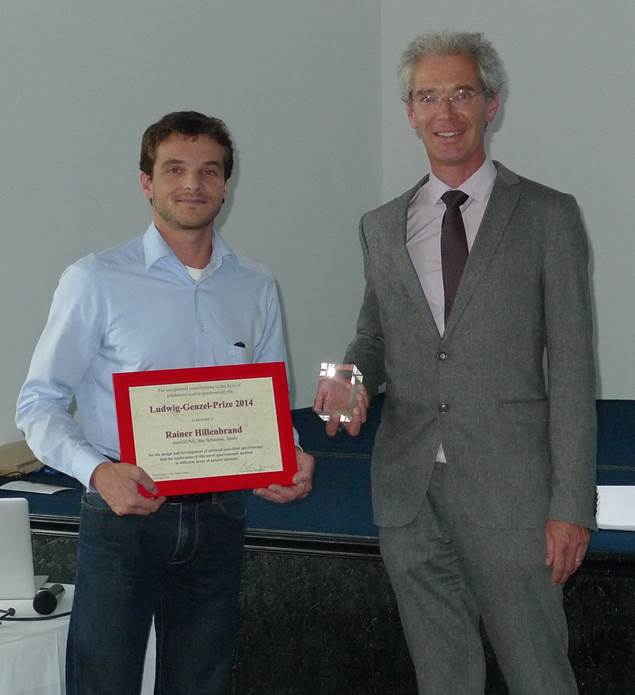
In 2008, Hillenbrand joined nanoGUNE as the group leader of the Nanooptics group and Ikerbasque Research Professor. He has applied his technique to perform cutting-edge research in different fields, including fundamental solid-state physics, materials science, life science, and nanophotonics. Recent developments include nanoscale infrared Fourier transform spectroscopy (nano-FTIR), which enables infrared spectroscopy with a more than 100 times improved spatial resolution compared to conventional infrared spectroscopy systems. Hillenbrand currently applies the techniques for chemical identification of nanomaterials, protein studies and the development of graphene-based nanophotonics.
According to the price committee, the revolutionary surface-imaging technique allows to perform spectrally resolved measurements from the visible to the microwave regime with an unprecedented spatial resolution. Hillenbrand work “reveals a unique combination of engineering skills and deep insights into the scientific problems of the various topics, addressing both fundamental questions and applications reaching all the way to industrial maturity”.
Ludwig-Genzel-Prize
The Ludwig-Genzel-Prize is awarded to a young scientist for exceptional contributions to the field of condensed-matter spectroscopy. Related to Ludwig Genzel’s scientific oeuvre the focus is on the far-infrared spectral range. The award contains a diploma and prize money of 4000 €. Bruker Optics (Ettlingen) is the sponsor of this prize. The prize is awarded every two years during the International Conference on Low Energy Electrodynamics in Solids (LEES). The selection is made by a committee. The current members of the selection committee are: Martin Dressel —chairman— (Univ. Stuttgart, Germany), Leonardo Degiorgi (EHT Zürich, Switzerland), Jan Petzelt (Academy of Sciences, Praha, Czech Republic), Karl Renk (Univ. Regensburg, Germany) and Hartmut Roskos (Univ. Frankfurt, Germany).
Nano-scale molecular detective: New on-chip device uses exotic light rays in 2D material to detect molecules
Molecules have some sort of fingerprints, unique features that can be used to differentiate them. Each type of molecule, when illuminated with the right light, vibrates at a characteristic frequency (its resonance frequency, which typically occurs at infrared frequencies) and strength. Similar to what can be done with human fingerprints, one can exploit this information to distinguish different types of molecules or gases from each other.
Infrared sheds light on single protein complexes
Proteins are basic building blocks of life. The chemistry and structure of proteins are essential for their biological function. Indeed, the structure of proteins determines their mechanical and catalytic properties (e.g. enzymes). Such functions literally shape all living beings. Furthermore, the protein structure also plays a major role in many diseases. For example, the secondary structure of a protein (whether it has helical (alpha-) or sheet-like (beta-) internal substructures) is highly relevant in the pathogenous mechanism leading to Alzheimer, Parkinson, and other neuro-degenerative diseases. Although a variety of methods have been developed to study the protein chemistry and structure, recognizing and mapping the secondary structure on the nanometer scale, or even with single protein sensitivity, is still a major challenge. A new infrared spectroscopy technique, called nano-FTIR, has now enabled nanoscale chemical imaging and probing of protein’s secondary structure with enormous sensitivity.
nano-FTIR is an optical technique that combines scattering-type scanning near-field optical microscopy (s-SNOM) and Fourier transform infrared (FTIR) spectroscopy. The latter is a tool often used for studying secondary structure of proteins that, however, does not allow for nanoscale mapping of proteins by itself. In nano-FTIR, a sharp metalized tip is illuminated with a broadband infrared laser beam, and the backscattered light is analyzed with a specially designed Fourier transform spectrometer. With this technique, the researchers could now demonstrate local infrared spectroscopy of proteins with a spatial resolution of less than 30 nm.
“The tip acts as an antenna for infrared light and concentrates it at the very tip apex. The nanofocus at the tip apex can be thus considered as an ultra-small infrared light source. It is so small that it only illuminates an area of about 30×30 nm, which is the scale of large protein complexes”, says project leader Rainer Hillenbrand.
In order to demonstrate the versatility of nano-FTIR for nanoscale-resolved protein spectroscopy, the researchers measured infrared spectra of single viruses, ferritin complexes, purple membranes and insulin fibrils. “They all exhibit variations of their secondary structure – describes Iban Amenabar, who performed the nanospectroscopy experiments-; viruses and ferritin are mainly made of alpha-helical structures, while insulin fibrils are mainly made of beta-sheet structures”. Simon Poly, the biologist in the team, explains that “in a mixture of insulin fibrils and few viruses, standard FTIR spectroscopy did not reveal the presence of the alpha-helical viruses. By probing the protein nanostructures one by one with nano-FTIR we could clearly identify the virus, that is the alpha-helical structures within the beta-sheet ones”.
An important aspect of enormous practical relevance is that the nano-FTIR spectra of proteins match extremely well with conventional FTIR spectra, while the spatial resolution is increased by more than 100. “We could measure infrared spectra of even single ferritin particles. These are protein complexes of only 24 proteins. The mass of one ferritin complex is extremely small, only 1 attogram, but we could clearly recognize its alpha-helical structure”, says Amenabar.
The researchers also studied single insulin fibrils, which are a model system for neurodegenerative diseases. It is known that insulin fibrils have a core of beta-sheet structure but their complete structure is still not fully clarified. “In nano-FTIR spectra of individual fibrils we recognized not only beta-sheet structure, but also alpha-helical structures, which might be of relevance for fibril association,” says Alexander Bittner, leader of the Self-Assembly Group at nanoGUNE.
“We are excited about the novel possibilities that nano-FTIR offers. With sharper tips and improved antenna function, we also hope to obtain infrared spectra of single proteins in the future. We see manifold applications, such as studies of conformational changes in amyloid structures on the molecular level, the mapping of nanoscale protein modifications in biomedical tissue or the label-free mapping of membrane proteins. This could lead to a new era in infrared nano-bio-spectroscopy”, concludes Rainer Hillenbrand, head of the Nanooptics Group at nanoGUNE.
Original publication
I. Amenabar, S. Poly, W. Nuansing, E. H. Hubrich, A. A. Govyadinov, F. Huth, R. Krutokhvostov, L. Zhang, M. Knez, J. Heberle, A.M. Bittner and R. Hillenbrand. “Structural analysis and mapping of individual protein complexes by infrared nanospectroscopy” Nature Communications, 2013, DOI: 10.1038/ncomms3890
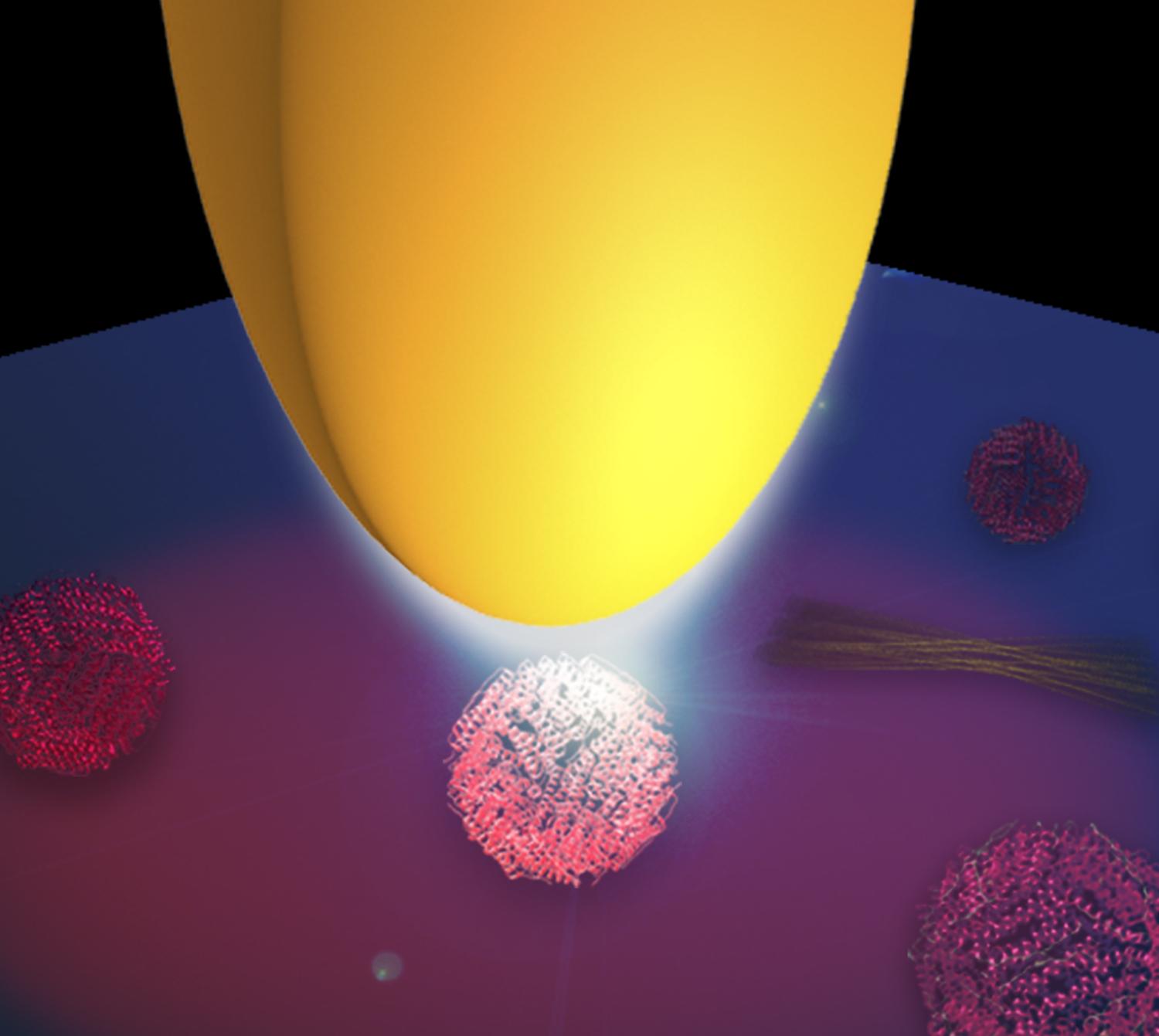
Figure: Illustration of infrared protein nano-spectroscopy. A metal tip (yellow) is illuminated with infrared light. Due the antenna function of the tip, the light is concentrated at the tip apex and creates a nanofocus, which illuminates the proteins. Copyright: CIC nanoGUNE
Science: Flatland optics with graphene
Optical circuits and devices could make signal processing and computing much faster. “However, although light is very fast it needs too much space”, explains Rainer Hillenbrand, Ikerbasque Professor at nanoGUNE and the UPV/EHU. In fact, propagating light needs at least the space of half its wavelength, which is much larger than state-of-the-art electronic building blocks in our computers. For that reason, a quest for squeezing light to propagate it through nanoscale materials arises.
The wonder material graphene, a single layer of carbon atoms with extraordinary properties, has been proposed as one solution. The wavelength of light captured by a graphene layer can be strongly shortened by a factor of 10 to 100 compared to light propagating in free space. As a consequence, this light propagating along the graphene layer – called graphene plasmon – requires much less space.
However, transforming light efficiently into graphene plasmons and manipulating them with a compact device has been a major challenge. A team of researchers from nanoGUNE, ICFO and Graphenea – members of the EU Graphene Flagship – now demonstrates that the antenna concept of radio wave technology could be a promising solution. The team shows that a nanoscale metal rod on graphene (acting as an antenna for light) can capture infrared light and transform it into graphene plasmons, analogous to a radio antenna converting radio waves into electromagnetic waves in a metal cable.
“We introduce a versatile platform technology based on resonant optical antennas for launching and controlling of propagating graphene plasmons, which represents an essential step for the development of graphene plasmonic circuits”, says team leader Rainer Hillenbrand. Pablo Alonso-González, who performed the experiments at nanoGUNE, highlights some of the advantages offered by the antenna device: “the excitation of graphene plasmons is purely optical, the device is compact and the phase and wavefronts of the graphene plasmons can be directly controlled by geometrically tailoring the antennas. This is essential to develop applications based on focusing and guiding of light”.
The research team also performed theoretical studies. Alexey Nikitin, Ikerbasque Research Fellow at nanoGUNE, performed the calculations and explains that “according to theory, the operation of our device is very efficient, and all the future technological applications will essentially depend upon fabrication limitations and quality of graphene”.
Based on Nikitin´s calculations, nanoGUNE’s Nanodevices group fabricated gold nanoantennas on graphene provided by Graphenea. The Nanooptics group then used the Neaspec near-field microscope to image how infrared graphene plasmons are launched and propagate along the graphene layer. In the images, the researchers saw that, indeed, waves on graphene propagate away from the antenna, like waves on a water surface when a stone is thrown in.

Graphic representation of the refraction of graphene plasmons – launched by a tiny gold antenna – when passing through a one-atom-thick prism
In order to test whether the two-dimensional propagation of light waves along a one-atom-thick carbon layer follow the laws of conventional optics, the researchers tried to focus and refract the waves. For the focusing experiment, they curved the antenna. The images then showed that the graphene plasmons focus away from the antenna, similar to the light beam that is concentrated with a lens or concave mirror.
The team also observed that graphene plasmons refract (bend) when they pass through a prism-shaped graphene bilayer, analogous to the bending of a light beam passing through a glass prism. “The big difference is that the graphene prism is only two atoms thick. It is the thinnest refracting optical prism ever”, says Rainer Hillenbrand. Intriguingly, the graphene plasmons are bent because the conductivity in the two-atom-thick prism is larger than in the surrounding one-atom-thick layer. In the future, such conductivity changes in graphene could be also generated by simple electronic means, allowing for highly efficient electric control of refraction, among others for steering applications.
Altogether, the experiments show that the fundamental and most important principles of conventional optics also apply for graphene plasmons, in other words, squeezed light propagating along a one-atom-thick layer of carbon atoms. Future developments based on these results could lead to extremely miniaturized optical circuits and devices that could be useful for sensing and computing, among other applications.
Original publication
P. Alonso-González1, A.Y. Nikitin1,5, F. Golmar1,2, A. Centeno3, A. Pesquera3, S. Vélez1, J. Chen1, G. Navickaite4, F. Koppens4<, A. Zurutuza3, F. Casanova 1,5, L.E. Hueso 1,5 and R. Hillenbrand 1,5. “Controlling grapheme plasmons with resonant metal antennas and spatial conductivity patterns” Science (2014), DOI: 10.1126/science.1253202
- CIC nanoGUNE, 20018 Donostia-San Sebastián, Spain.
- I.N.T.I-CONICET and ECyT-UNSAM, San Martín, Bs. As., Argentina.
- Graphenea SA, 20018 Donostia-San Sebastián, Spain.
- ICFO-Institut de Ciéncies Fotoniques, Mediterranean Technology Park, 08860 Casteldefells, Barcelona, Spain.
- IKERBASQUE, Basque Foundation for Science, 48011 Bilbao, Spain.
CIC nanoGUNE
The nanoGUNE Cooperative Research Center, located in Donostia-San Sebastian, Basque Country, is a research centre set up with the mission to conduct excellence research into nanoscience and nanotechnology with the aim of increasing the Basque Country’s business competitiveness and economic and social development.
GRAPHENEA S.A.
Graphenea is a pioneer graphene production start-up company founded in 2010 by private investors and CIC nanoGUNE. The company produces and commercializes graphene films by Chemical Vapor Deposition technology and graphene powders by Chemical Exfoliation techniques.
ICFO
ICFO is a young research institution located in Barcelona that aims to advance the very limits of knowledge in Photonics, namely the science and technology of harnessing Light. Its research programs target the global forefront of photonics, and aim to tackle important challenges faced by society at large. ICFO is focused on current and future problems in Health, Energy, Information, Safety, Security and caring for the Environment.
Basque researchers turn light upside down

Scientists had already theoretically predicted that specifically structured surfaces can turn the wavefronts of light upside down when it propagates along them. "On such surfaces, called hyberbolic metasurfaces, the waves emitted from a point source propagate only in certain directions and with open (concave) wavefronts", explains Javier Alfaro, PhD student at nanoGUNE and co-author of the paper. These unusual waves are called hyperbolic surface polaritons. Because they propagate only in certain directions, and with wavelengths that are much smaller than that of light in free space or standard waveguides, they could help to miniaturize optical devices for sensing and signal processing.
Now, the researchers developed such a metasurface for infrared light. It is based on boron nitride, a graphene-like 2D material, and was selected because of its capability to manipulate infrared light on extremely small length scales, which could be applied for the development of miniaturized chemical sensors or for heat management in nanoscale optoelectronic devices. On the other hand, the researchers succeeded to directly observe the concave wavefronts with a special optical microscope, which have been elusive so far.
Hyperbolic metasurfaces are challenging to fabricate because an extremely precise structuring on the nanometer scale is required. Irene Dolado, PhD student at nanoGUNE, and Saül Vélez, former postdoctoral researcher at nanoGUNE (now at ETH Zürich) mastered this challenge by electron beam lithography and etching of thin flakes of high-quality boron nitride provided by Kansas State University. "After several optimization steps, we achieved the required precision and obtained grating structures with gap sizes as small as 25 nm”, Dolado says. “The same fabrication methods can also be applied to other materials, which could pave the way to realize artificial metasurface structures with custom-made optical properties”, adds Saül Vélez.
To see how the waves propagate along the metasurface, the researchers used a state-of the-art infrared nanoimaging technique that was pioneered by the nanoptics group at nanoGUNE. They first placed an infrared gold nanorod onto the metasurface. “It plays the role of a stone dropped into water”, says Peining Li. The nanorod concentrates incident infrared light into a tiny spot, which launches waves that then propagate along the metasurface. With the help of a so-called scattering-type scanning near-field microscope (s-SNOM) the researchers imaged the waves. “It was amazing to see the images. They indeed showed the concave curvature of the wavefronts that were propagating away form the gold nanorod, exactly as predicted by theory“, says Rainer Hillenbrand, Ikerbasque Professor at nanoGUNE, who led the work.
The results promise nanostructured 2D materials to become a novel platform for hyberbolic metasurface devices and circuits, and further demonstrate how near-field microscopy can be applied to unveil exotic optical phenomena in anisotropic materials and for verifying new metasurface design principles.
The research has been mainly funded by individual fellowship grants of the European Union Marie Sklodowsca-Curie Actions and the pre-doctoral research grants program of the Basque and Spanish Governments, as well as by the National Science Foundation (USA), and has been carried out in line with nanoGUNEs projects within the EU's Graphene Flagship.

